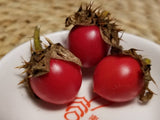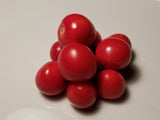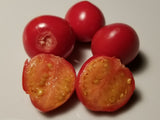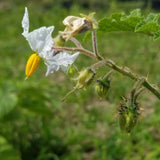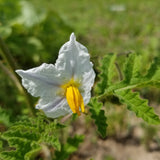(Solanum sisymbriifolium); aka litchi tomato, Morelle de Balbis, vila-vila, sticky nightshade, red buffalo-bur, or the fire-and-ice plant; Minimum 50 seeds
Bushes grow to 5 feet with sprawling branches and are covered with spines that require care when handling (similar to raising raspberries or gooseberries.) High in anti-oxidants, vitamin C, beta-carotene, and polyphenols, the uniquely flavored sweet berries are medium sized, red on the outside and orange inside. Berries grow inside a spiny, green husk that browns and shrinks as it dries. When the fruit is ripe it is easily removed from the stem.
Prolific, low maintenance plants produce until frost. Used as a natural perimeter fencing, the large, spiny bushes assist in critter deterrence and are a magnet for tomato hornworms and Colorado potato beetles. Planted in rotation or as a companion crop, Litchi Tomato plants are an excellent trap crop for potato cyst nematodes.
Due to their unruly and imposing nature, we lovingly call these plants our "Little Shop of Horrors" plants.
Please see Litchi Tomato Garden Berry: Plant, Grow, Use, & Save Seed
Nutritional information from the 2015 paper Phytonutrient content of Solanum sisymbriifolium Lam. berries in The Journal of Food Composition & Analysis'
Important note: this crop has the potential to become a dominant invasive species. In our experience, in our frequent monitoring of the progression of ripening, we notice no evidence of loss of berries to birds / critters due to the heavily bristled husks on the berries and the overall spiny nature of the plants themselves. Additionally, berries do not readily drop from the plant. Please see this USDA bulletin.







